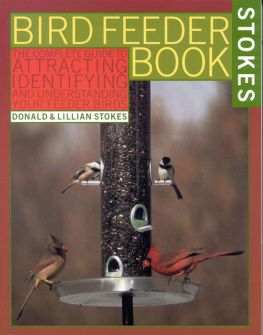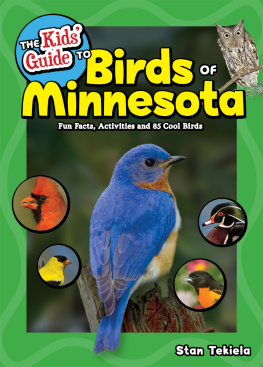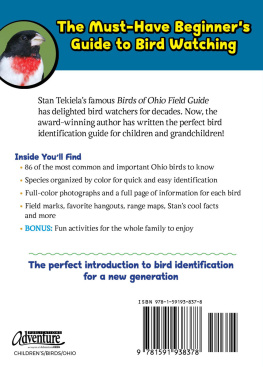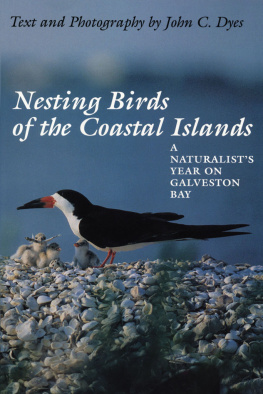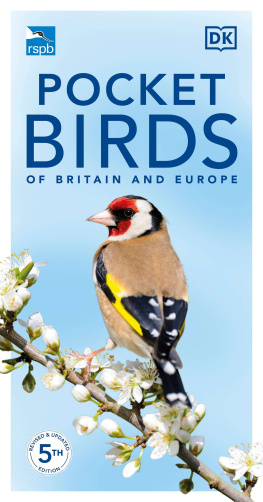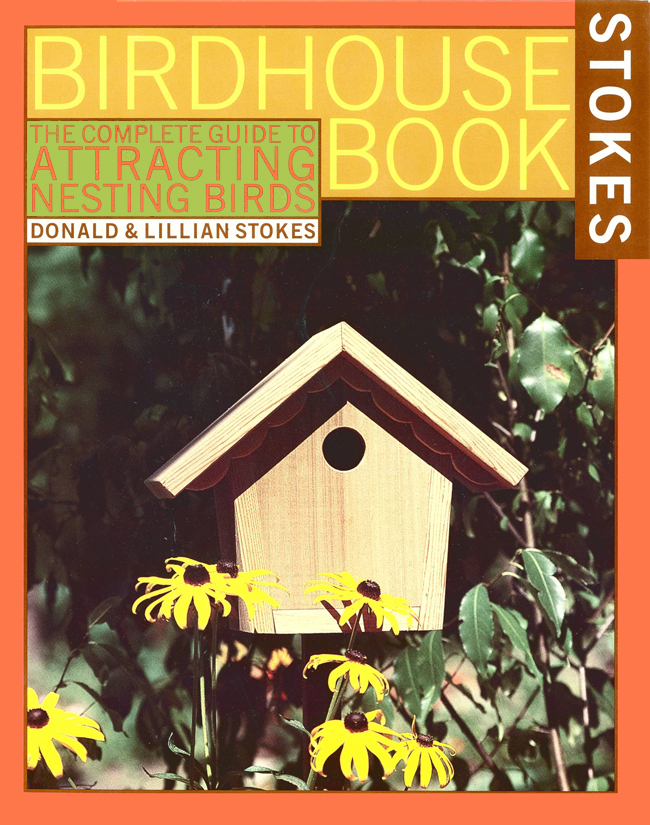Copyright 1990 by Donald W. Stokes and Lillian Q. Stokes
All rights reserved. Except as permitted under the U.S. Copyright Act of 1976, no part of this publication may be reproduced, distributed, or transmitted in any form or by any means, or stored in a database or retrieval system, without the prior written permission of the publisher.
Little, Brown and Company
Hachette Book Group
237 Park Avenue
New York, NY 10017
Visit our website at www.HachetteBookGroup.com
www.twitter.com/littlebrown
First eBook Edition: September 2009
ISBN: 978-0-316-08493-2
STOKES
BIRDHOUSE BOOK
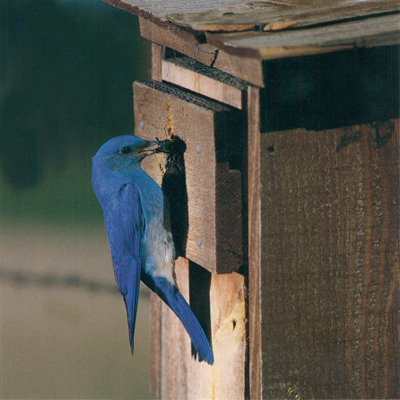
Stokes Field Guides
Stokes Field Guide to Birds: Eastern Region
Stokes Field Guide to Birds: Western Region
Stokes Field Guide to Bird Songs: Eastern Region (CD/cassette)
Stokes Field Guide to Bird Songs: Western Region (CD/cassette)
Stokes Field Guide to Warblers
Stokes Beginners Guides
Stokes Beginners Guide to Bats
Stokes Beginners Guide to Bird Feeding
Stokes Beginners Guide to Birds: Eastern Region
Stokes Beginners Guide to Birds: Western Region
Stokes Beginners Guide to Butterflies
Stokes Beginners Guide to Dragonflies
Stokes Beginners Guide to Hummingbirds
Stokes Beginners Guide to Shorebirds
Stokes Backyard Nature Books
Stokes Bird Feeder Book
Stokes Bird Gardening Book
Stokes Birdhouse Book
Stokes Bluebird Book
Stokes Butterfly Book
Stokes Hummingbird Book
Stokes Oriole Book
Stokes Purple Martin Book
Stokes Wildflower Book: East of the Rockies
Stokes Wildflower Book: From the Rockies West
Stokes Nature Guides
Stokes Guide to Amphibians and Reptiles
Stokes Guide to Animal Tracking and Behavior
Stokes Guide to Bird Behavior, Volume 1
Stokes Guide to Bird Behavior, Volume 2
Stokes Guide to Bird Behavior, Volume 3
Stokes Guide to Enjoying Wildflowers
Stokes Guide to Nature in Winter
Stokes Guide to Observing Insect Lives
Other Stokes Books
The Natural History of Wild Shrubs and Vines
Photograph Acknowledgments
Animals/Animals: R. H. Armstrong .
Bruce Coleman, Inc.: Bob and Clara Calhoun .
Cornell Laboratory of Ornithology: Warren Greene .
Irene Hinke-Sacilotto: top.
Denny Mallory: .
Maslowski Photo: .
Myrna D. Pearman: .
Photo Researchers: Bob and Elsie Boggs .
Sid Rucker: .
Lorne Scott: .
Bryan Shantz: bottom.
John Shaw: .
Stokes Nature Company: Don and Lillian Stokes/Dianne McCorry .
VIREO: Herbert Clarke .
Mark Wilson: .
The authors would like to thank Elsie Eltzroth of Corvallis, Oregon, for supplying them with the breeding information on the western bluebird.
Attracting Nesting Birds
Many years ago, we decided to try our hand at attracting nesting birds. It was a gray and blustery day in late March, just warm enough so that the ground was partially thawed. There were no signs of birds yet, just us, our boxes, and some posts. We had fun plotting the best locations for each box, but we wondered, as we pounded in the posts, would the birds really come to nest in our meadow?
We put up five birdhouses and then forgot about them until a few days later, when we were driving by the field and saw our first visitor. There, perched on the birdhouse closest to the road and right next to our mailbox, was a beautiful tree swallow.
On our approach, it flew up momentarily. Then, to our excitement, it landed right at the entrance to the birdhouse, peered in cautiously, rocked in and out several times, and finally went all the way in and looked out at us. We had a prospective tenant!
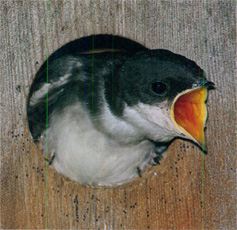
A young tree swallow nestling in one of our birdhouses calling out for more food from its busy parents.
We were even more excited one morning several days later when we saw two tree swallows sitting on the box, for this meant that we now had a mated pair. We anticipated the joy of watching them raise a family.
Each day brought a new surprise. First we would see the female carrying in strands of dried grasses as she fashioned the nest. The male watched from the top of the box, chasing after any other intruding tree swallows, for others had also arrived at the meadow. At the end of nest building, we saw the female arrive with some beautiful white feathers. Where she had gotten them was a mystery until we later learned that some friends nearby kept chickens.
One day, when we had seen the female fly off to catch insects, we cautiously opened the nest box and discovered five snow-white eggs nestled in the soft feathers. We closed up the box and watched her return and enter to resume incubating. She sat on the eggs for 15 days, in rain, cold, and heat, taking only brief trips away from her precious job to fly around and gather insects for herself and a few times to land on the box, stretch her wings, and preen her feathers.
When both parents began to bring food to the nest, we knew that the babies had hatched. If both parents arrived at once, one would cling patiently to the entrance hole, ducking in when the other one left.
Near the end of the nestling phase, the feeding trips by the parents became more frequent, and we could hear the babies call excitedly when a parent landed on the box. Soon we saw two little heads peering out; the babies were now big enough to expectantly survey the world. We could see some jostling occur as first one, then another, vied to look.
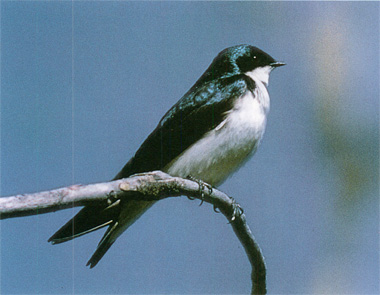
An adult tree swallow in all of its beautiful iridescence.
Exactly 21 days after the babies had hatched, we were fortunate enough to see the first one leave the birdhouse. It had squeezed so far out of the hole that there was no turning back, so it launched into the air on its first flight. We held our breath, but did not need to worry. By the time they leave the nest, tree swallows are fairly strong flyers, though they are a little clumsy on their first attempts to land.
Soon all of the young had fledged. The family stayed another day or so in the vicinity of the birdhouse, but never went back in it. The young were fed a little by the parents and then became skillful at catching their own insects in midair.
Then one day, when we went out to the field, we saw that they had all left. We missed them, knowing we would have to wait until the next spring to have them again, swooping and soaring over our garden. We wished them a safe migratory journey and a good season in their wintering home, the southern United States coast and Central America. During those months we would clean out their box and make it ready for their return.
Bolstered by our initial success, and addicted to the joy of gaining this intimate view of the family life of the birds, we have, over the years, added greatly to the types and numbers of nesting boxes on our suburban property. We have been fortunate enough to have attracted 12 species of cavity nesters and more than 30 other species of nesting birds.


